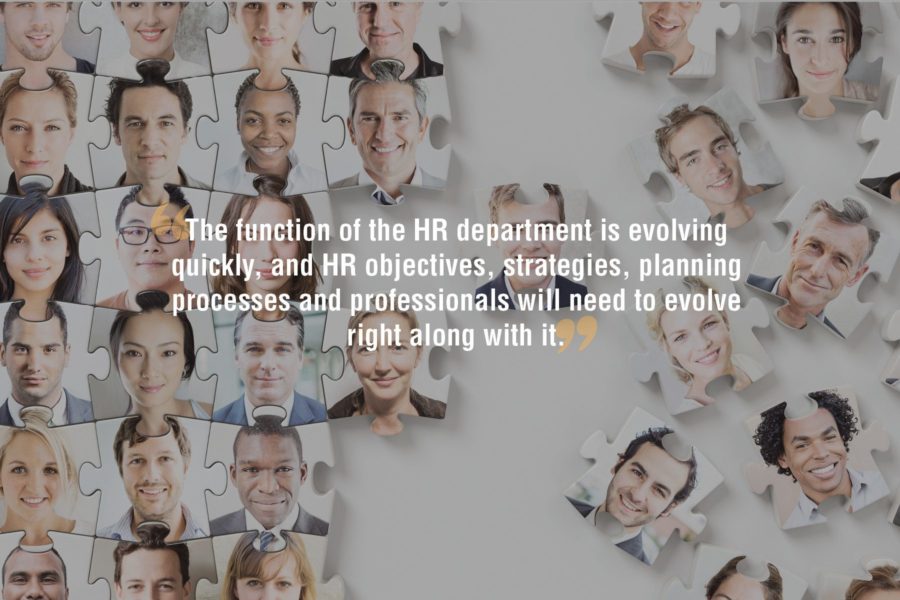The human resources department has come a long way since having the role of simply hiring and firing, determining benefits and following regulations. With technology automating many of the day-to-day human resources processes, the HR professional’s role has moved from being simply “personnel” to a more integral part of a company’s infrastructure.
Human resources departments of today are now focusing on areas such as recruiting, employee engagement and culture, training and development, succession planning, team building initiatives, wellness programs, company branding and more.
Strategic Goals to Consider in 2021
Not all human resources departments are created alike, nor do all have the same business strategy and goals. While your HR department may not have the bandwidth to support positions dedicated to each program or initiative, exploring these strategic objectives in some way can help increase the quality of your employees, their satisfaction with their workplace, employee retention long term and your reputation in the industry.
Here are some best human resource management practices and areas in which human resources management can make a difference, as well as some creative ideas for your organization to consider when implementing new programs and initiatives.
Evaluate Your Company Culture
Company culture is an ever-changing way that an organization remains relevant and attractive to potential employees. “Culture” encompasses everything from compensation and benefits and employee morale and well-being to work environment and productivity and more.
Ask yourself these questions:
- Does your company have a vision, mission and values statement? If so, does your company and its employees mirror them effectively? If not, what needs to be changed?
- What are employees’ opinions about the company? Are you aware of them or have ways to solicit that feedback?
- Are compensation and performance incentives fair and within industry benchmarks?
- How do the business owners and other managers interact and communicate with employees?
- Are employees encouraged to provide feedback or speak up when there are issues – and are there the proper resources to do so?
- Does your organization have a concrete plan and business strategy when it comes to creating goals for your company culture?
- Do you have a succession plan in place for when the baby boomers in your leadership begin to retire?
If you answered “no” to any of these questions, the following information will be of great benefit as you work toward your HR department’s goals for the year ahead.
Use Social Media for Recruiting
If social media isn’t in your HR plan, it’s time to include it. Consider these statistics:
- 73 percent of workers between ages 18 and 34 found their last job via social recruiting (Aberdeen Group).
- 49 percent of professionals are following companies on social media with the intent to stay aware of their jobs (LinkedIn).
- Nearly 90 percent of surveyed companies had successfully hired a candidate through LinkedIn (Capterra).
- 81 percent of job seekers were cited saying they wish to see more job opportunities listed on Facebook (Link Humans).
- 59 percent of recruiters cited finding high-quality candidates when sourcing from social media (SproutSocial).
- 70 percent of job seekers are searching for jobs on mobile (CareerBuilder).
In fact, 47 percent of recruiters choose social media as their top platform of choice when it comes to their employer branding attempts (Jobvite).
Yes, many of your future hires are looking for your company on Facebook, Twitter, LinkedIn and even Instagram, and these platforms go hand-in-hand with traditional means of recruiting. In addition to knowing about the job and the company, potential candidates want to know what it’s like to work there, which is why profiles on sites like Glassdoor are important.
With Glassdoor, employees past and present can rate your company and share their thoughts on everything from working environment and culture to salary and benefits and more. Of course, the higher your rating, the better you’ll appeal to potential candidates, which can give you a competitive advantage over other companies.
Ask Your Employees
If you haven’t conducted an employee survey, now is the time to add it to your strategic plan. Employees most often have strong opinions about the organizations for which they work, and human resources management would be wise to listen. Anonymous surveys can solicit feedback on everything from company policies, salaries, employee recognition, training, advancement opportunities, accessibility of management, benefits and more. HR departments are essentially the change agents for organizations if they are prepared to make adjustments to the organization based on employee feedback.
Focus on Training and Development
One key HR strategy to have is a good training and development plan. According to a 2018 Workplace Learning Report by LinkedIn, 94 percent of employees would stay at a company for the long term if it made efforts to invest in their career, reporting that effective employee development can increase employee performance by up to 25 percent.
Employee training and development can begin with on-boarding, ensuring new employees receive the proper training for the job they have been hired to perform. From there, performance milestones and goals can be set, with appropriate job training along the way. As employees progress in their positions, performance reviews should include an overview of strengths and weaknesses, with recommendations made for future training and development based on mutual agreement between the manager and employee.
It’s also important to start identifying the leaders of tomorrow – today – so transitions to these leadership roles can be made smoothly. HR departments should have a strategy to identify these positions within the company, assess the nature of those jobs in the future, source talent within your organization and ensure that managers take steps to groom successors. Successful training programs focus on all areas of employee development, from technology and business processes to leadership, communication and other soft skills.
Review Compensation and Benefits
An obvious initiative that should be regularly undertaken is a review of your employee compensation and benefits. What should be included in this review is the compensation strategy, pay structure and processes, employee recognition and retention and benefit policies. As budgets and salary benchmarks change, so should your compensation and benefits packages.
Employee compensation must be considered during quarterly or annual reviews, and high-performing employees should be acknowledged with pay increases to improve employee retention. Organizations should stay up to date with current benefits practices, evaluating employee needs through surveys and other means of feedback.
Improve Employee Engagement
As the hub of the company, it makes sense for the HR department to be the center for employee engagement efforts. This process starts even before an employee is hired. Above and beyond evaluating whether a candidate has the right skills for the job, it’s important to also measure if that person is a good culture fit for your organization.
Consider your company’s mission, values and vision and the attributes of the employees there who seem to embody those traits. From there, it’s important to ensure that employees know the job they were hired to do, are communicated with throughout their tenure and acknowledged for their performance both in verbal and monetary recognition.
In addition, it’s crucial that employees know their opinions matter and are instrumental in changes and improvements made to the organization. The more employees feel a part of a company and the more information they are given, the more invested they will be, the longer they’ll stay and the more likely they’ll promote your organization, enhancing both your reputation and recruiting efforts.
Reevaluate Remote Work Policies
Remote work has become more prevalent in recent years, but the COVID-19 pandemic made it virtually ubiquitous. Working remotely is now more desired and more accepted than ever before. As a result, many organizations will need to rethink everything from recruiting, interviewing and onboarding to technology, engagement and measuring performance.
A survey of businesses conducted in April 2020 by The Conference Board found that before the pandemic, 76 percent of companies had less than 10 percent of their full-time employees working from home at least three days per week. However, 83 percent of companies expect that after the pandemic, full-time employees will continue working from home at least three days per week.
This means that your human resources department might need some revamping to include detailed information on remote work. This should complement current on-site employee policies so as not to alienate remote workers from the rest of the workforce.
Make clear what “flexibility” means: are all employees required to work during certain times of day and certain days of the week? Are all employees required to track their time or post the status of certain projects?
Does human resources handle vacation and sick time the same for on and offsite employees? Are remote employees required to attend in-person meetings or reviews at any point? And are there stipulations in which an employee can or cannot work remotely? Not outlining remote worker policies and procedures can cause confusion, misunderstandings and the possibility of resentment between your on-site and remote workforce.
Take a Look at Technology
If your organization doesn’t already have a strategic plan when it comes to technology, now is the time to get one. Especially due to the COVID-19 pandemic, the need for upgraded HR technology to support a growing remote workforce is greater than ever.
Remote tools such as Microsoft Teams and Zoom are being used for more than just meetings; they are now an integral part of the interviewing and hiring process. Human resources should be well-versed in these tools and be able to provide them – along with training – to all employees.
Online training courses put the power of learning potential in the hands of the employees by allowing them to learn at their own pace and schedule, viewing courses on-demand rather than having to attend a live conference. Online employee wellness tools, from finances to physical and mental health, are promoting good lifestyle habits outside of the workplace, employee camaraderie and easy, online assistance.
How well is your wellness program?
A 2019 study by Aflac showed that 70 percent of employees enrolled in wellness programs have reported higher job satisfaction than those not enrolled in the companies’ programs.
Wellness programs can encompass all aspects of health, including physical, mental, financial and social. Studies have shown that wellness programs can:
- Lower health risks and reduce medical costs
- Decrease employee absenteeism
- Decrease stress
- Improve employee productivity
- Aid in employee recruitment and retention
- Increase employee moral
Elements of a good wellness program can include:
- Lifestyle improvement initiatives
- Fitness tracking
- Health assessments including risk appraisals
- On-site screenings
- Education and support groups
- Financial counseling
- Mental health programs and access to counseling
The function of the HR department is evolving quickly, and HR objectives, strategies, planning processes and HR professionals will need to evolve right along with it. Staying up to date on the latest strategies and best practices can help keep your organization relevant and successful. Contact our HR Services for more information.





